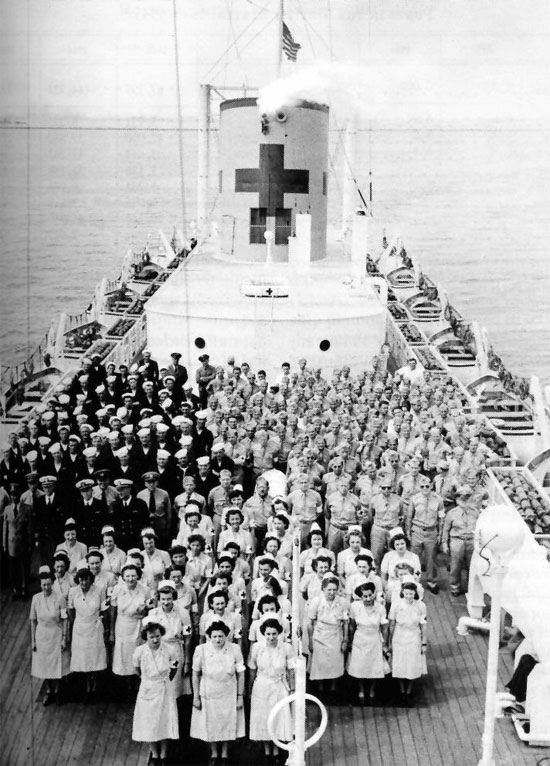

Pennock reported to his Flag officer, "The boat is supplied with everything necessary for the restoration of health for the disabled seamen." Enough stores were taken aboard for a crew and 200 patients for three months. That summer, the ship was renovated by the Army Quartermaster Corps to include laundries, bathroom facilities, elevators to upper decks, operating rooms, nine water closets, separate kitchens for crew and patients, and gauze blinds to keep out smoke and cinders from the convalescents' berth deck. Not long after her capture, the Red Rover became a haven for many injured men and officers of the apprehending gunboat. She was captured by the Union gunboat Mound City and almost immediately prepared as a floating hospital for the casualties of the North. Although she leaked considerably, the ship was in no danger of sinking. When New Orleans was bombarded by the Union’s Western Gunboat Flotilla in March 1862, the Red Rover was hit by a shell that pierced her top and slanted through all her decks to the bottom. This steamer was used originally as living quarters for the men manning the Confederate States' Floating Battery New Orleans. USS Red Roverĭuring the Civil War, a captured side-wheel steamer named by its Confederate owner the Red Rover, proved to be the U.S. Fittingly enough the name was changed to the Florence Nightingale, and a number of patients were cared for aboard her. Her engines were removed, the deck was housed over, and other necessary facilities were installed.

After his idea was accepted, the port authorities voted funds to purchase the steamer Falcon. William Adison, recently returned from England where he had studied in the floating hospital ship Caledonian, suggested a similar vessel. The infected sailors were turned away by the New York marine hospital, and it was necessary to find a place to treat them. In 1859, the threat of yellow fever, an epidemic brought on by seamen returning from foreign ports, led to the first floating hospital in America. Intrepid is better known, however as the ship that sneaked under the eyes of the enemy and blew up the Philadelphia held captive by the Tripolitans. The United States, as did other countries with navies, also found a use for such ships.ĭuring the Tripoli piracy era of 18, Commodore Preble designated the captured ketch Intrepid as a ship with hospital duties. Ancient history tells how the Romans used special boats to remove the sick and wounded. Part 1: Tripoli to The Spanish American WarĪlmost as long as there have been wars fought on or near waters there have been vessels used to care for casualties. His books include Industrializing American Shipbuilding: The Transformation of Ship Design and Construction, 1820-1920 and Cruise of the Dashing Wave: Rounding Cape Horn in 1860. in University of Delaware’s Hagley Program in the History of Industrialization and Technology, with a specialization in maritime industries and technology. Thiesen earned a master’s degree from East Carolina University’s Program in Maritime History, with a concentration in naval history and a Ph.D. Prior to working for the Coast Guard, he taught history at the undergraduate and graduate levels and served as curator and assistant director for five years at the Wisconsin Maritime Museum, the largest maritime museum on the Great Lakes. Thiesen serves as Atlantic Area Historian for the United States Coast Guard. This paper will explore the life and career of Captain Michael Healy, the most colorful and controversial officer in the history of the United States Coast Guard.ĭr. During Healy’s career in Alaska, he explored, policed, protected, nurtured, defended and helped preserve the humans and animals that survived in that forbidding land. As a powerful law enforcement officer in Alaska Territory, he helped shape the history of this lawless maritime frontier. sea service commission and first to command a Federal ship. Michael Healy made a lasting impression on American history as the first man of African-American heritage to receive a U.S. Healy’s career tied him to the taming of Alaska, America’s last frontier, and made him possibly the most interesting and controversial captain in Coast Guard history. Atlantic Area Historian, US Coast Guard.Īs with so many forgotten Coast Guard stories of heroism, bravery and courage, the story of Michael Augustine Healy is unknown to most Americans. Join us at 1900 EDT on 27 October at for our next Naval History Virtual Lecture: Revenue Cutter Captain “Hell Roarin’” Mike Healy-tamer of America’s final frontier.


 0 kommentar(er)
0 kommentar(er)
